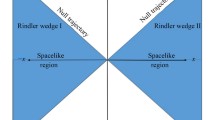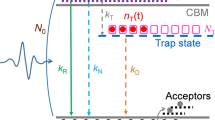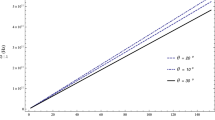Abstract
Quantum dots (QDs) have unique optical properties that are widely used in optoelectronics, biology, and medicine. The problem of controlling the spectral and luminescent properties of QDs has initiated studies of the mechanisms by which QDs interact with each other and with the surrounding matrix. Such interactions can, under certain conditions, significantly modify the radiative properties of QDs, which will affect the characteristics of laser structures and biosensors based on them. The aim of this work is a theoretical study of the 2D dissipative tunneling effect in the “QD–surrounding matrix” system, as well as the pair electrostatic interaction of QDs with A+ + e impurity complexes, on recombination radiation associated with the optical transition of an electron from the QD ground state to the quasi-stationary A+ state in an external electric field. The interaction of an electron, which is in the ground state of a QD, and a hole that is localized at the A+ center has been considered within the framework of the adiabatic approximation. The dispersion equations that determine dependence of the hole binding energy in the A+ + e impurity complex in a spherically symmetric QD on the external electric field and dissipative tunneling parameters have been obtained within the zero range potential model, in the effective mass approximation. Calculation of the spectral intensity of recombination radiation (SIRR) in QDs with an A++e impurity complex in an external electric field has been performed in the dipole approximation. Influence of the electric field on the ground state of an electron in a QD has been taken into account in the second order of the perturbation theory. Numerical calculations and plotting were carried out for a semiconductor quantum dot based on InSb using the symbolic mathematics of Mathcad 14 and Wolfram Mathematica 9. The 2D dissipative tunneling probability has been calculated with exponential accuracy for the 2D oscillatory potential model at a finite temperature, taking into account the linear interaction with the phonon modes of the environment media (or a heat bath) in the one-instanton semiclassical approximation. It is shown that the field dependence of the binding energy for the quasi-stationary A+ state has an oscillating character, associated with quantum beats that occur during parallel 2D tunneling transfer. It is found that the SIRR curves have a characteristic kink corresponding to the 2D bifurcation point that occurs when the tunneling regimes in the interacting pair of QDs change from synchronous to asynchronous. It has been established that, in the vicinity of the 2D bifurcation point, there are irregular oscillations in the SIRR associated with the modes of quantum beats, in the course of which competing trajectories of tunneling appear. It is found that the parameters of dissipative tunneling—the temperature, frequency of the phonon mode, constant of interaction with the contact medium, constant of the QDs interaction—have a significant effect on the amplitude of quantum beats and the position of the 2D bifurcation point in the SIRR. Taking into account the interaction of the QD with the surrounding matrix leads to a significant modification of the SIRR, which manifests itself in the form of bifurcation points and quantum beats that depend on the dissipative tunneling parameters. Accounting for the pairwise interaction of QDs with each other via hole repulsion in A+ + e complexes leads to suppression of recombination radiation with an increase in the interaction constant.



Similar content being viewed by others
REFERENCES
A. O. Orlova, V. E. Adrianov, V. G. Maslov, P. S. Parfenov, A. V. Baranov, and A. V. Fedorov, Opt. Spectrosc. 108 (6), 934 (2010). https://doi.org/10.1134/S0030400X10060160
M. A. Anton, Opt. Commun. 508, 127811 (2022).
A. I. Ekimov, A. A. Onushchenko, and Al. L. Efros, JETP Lett. 43 (6), 376 (1986). http://jetpletters.ru/ps/1404/article_21323.pdf
J. Leggett, Yu. N. Ovchinnikov, V. D. Krevchik, M. B. Semenov, P. B. Semenov, et al., Controlled Dissipative Tunneling. Tunnel Transport in Low-Dimensional Systems. Monograph Dedicated to the Memory of Prof. A.I. Larkin, Ed. by A. J. Leggett (Fizmatlit, Moscow, 2011–2012) [in Russian].
V. D. Krevchik and A. V. Levashov, Phys. Solid State 48 (3), 589 (2006). https://doi.org/10.1134/S1063783406030280
V. D. Krevchik, A. V. Razumov, M. B. Semenov, S. U. Uvaysov, V. P. Kulagin, P. Komada, S. Smailova, and A. Mussabekova, Sensors 22 (4), 1300 (2022). https://doi.org/10.3390/s22041300
A. V. Levashov, V. D. Krevchik, M. B. Semenov, and A. V. Razumov, Izv. Vyssh. Uchebn. Zaved., Povolzhsk. Reg. Fiz.-Mat. Nauki, No. 1, 83 (2022).
Gradshtein I. S. and I. M. Ryzhik, Tables of Integrals, Series, and Products (Academic, New York, 1965).
Funding
This work was supported by a grant from the Ministry of Science and Higher Education of the Russian Federation, project no. 0748-2020-0012.
Author information
Authors and Affiliations
Corresponding author
Ethics declarations
The authors declare that they have no conflicts of interest.
Additional information
Translated by M. Drozdova
Publisher’s Note.
Pleiades Publishing remains neutral with regard to jurisdictional claims in published maps and institutional affiliations.
Rights and permissions
About this article
Cite this article
Krevchik, V.D., Razumov, A.V. & Semenov, M.B. The Effects of 2D Dissipative Tunneling for the Recombination Radiation Spectra of Interacting Quantum Dots in an External Electric Field. Tech. Phys. 68, 93–101 (2023). https://doi.org/10.1134/S1063784223020056
Received:
Revised:
Accepted:
Published:
Issue Date:
DOI: https://doi.org/10.1134/S1063784223020056




